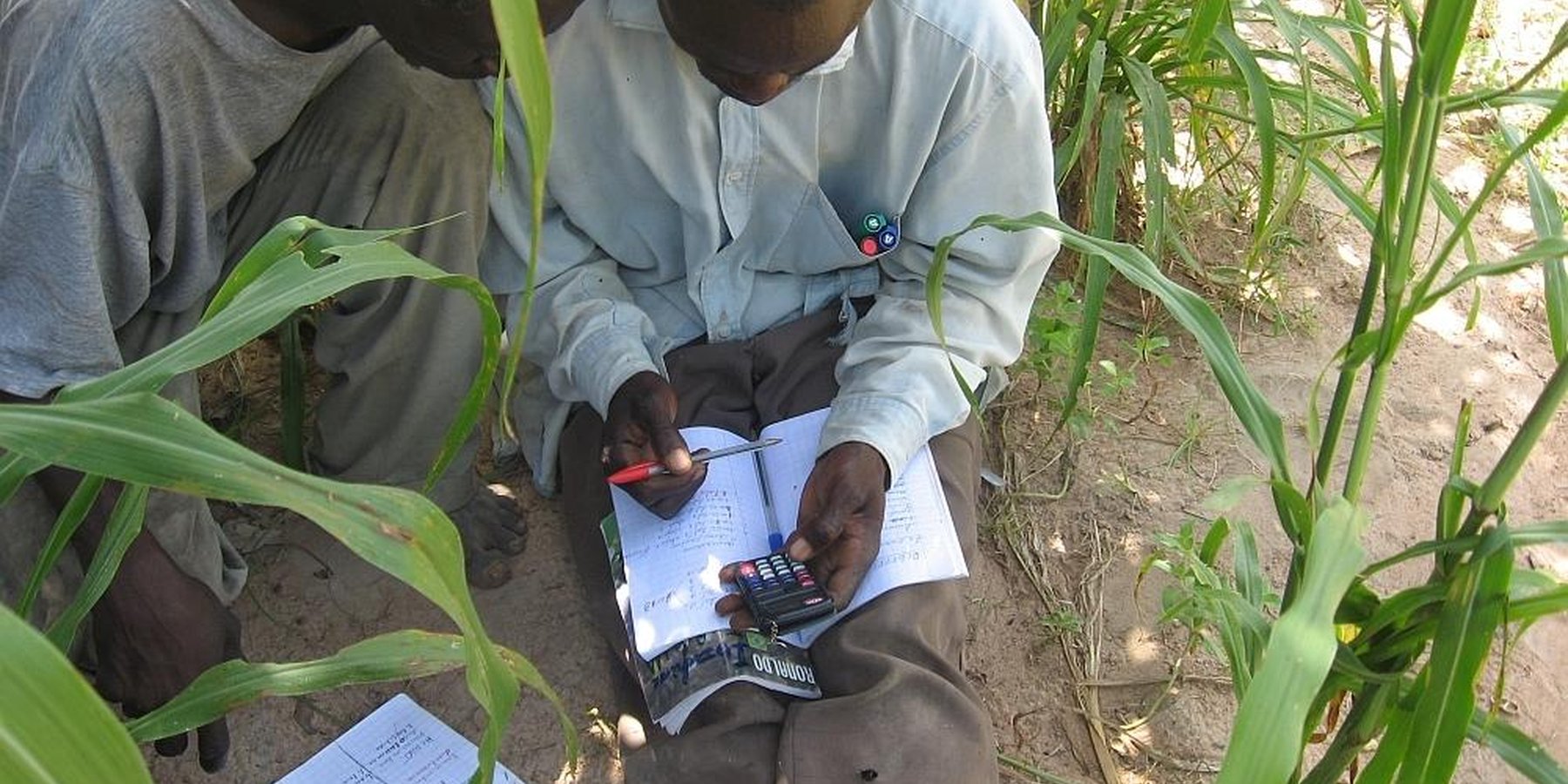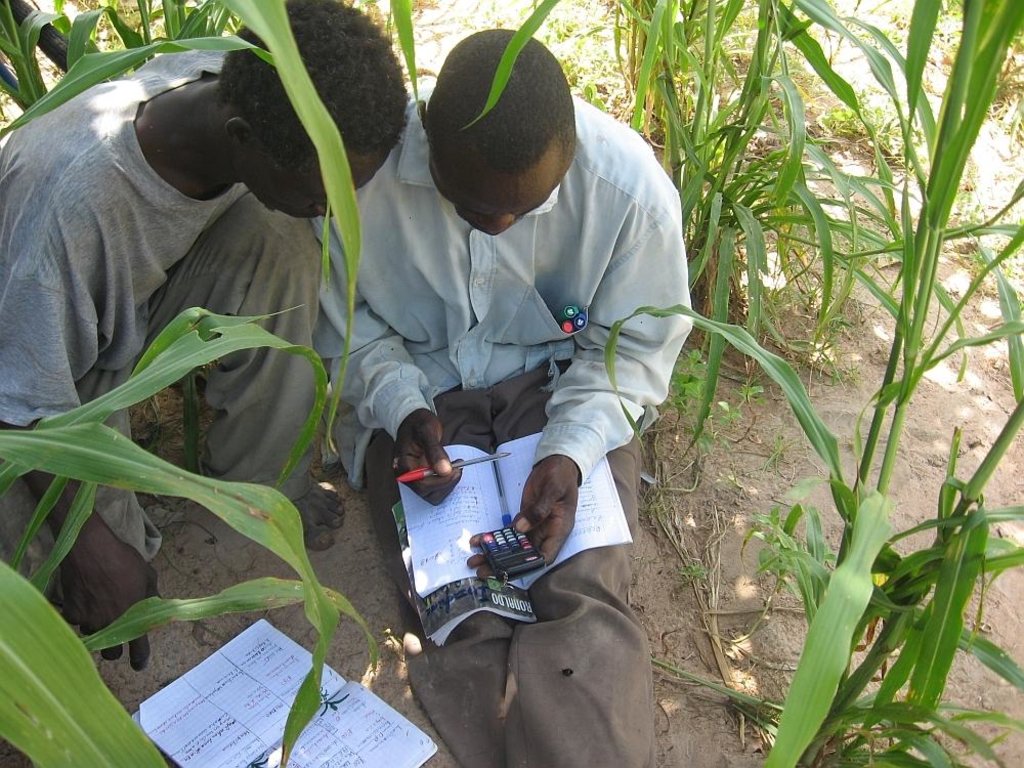Locally sourced farming trainers: the farmer resource persons system [ប្រទេសម៉ាលី]
- ការបង្កើត៖
- បច្ចុប្បន្នភាព
- អ្នកចងក្រង៖ Dieter Nill
- អ្នកកែសម្រួល៖ –
- អ្នកត្រួតពិនិត្យ Laura Ebneter
Approche paysanne formateur endogène: dispositif de personnes ressources paysannes
approaches_2507 - ប្រទេសម៉ាលី
ពិនិត្យមើលគ្រប់ផ្នែក
ពង្រីកមើលទាំងអស់ បង្រួមទាំងអស់1. ព័ត៌មានទូទៅ
1.2 ព័ត៌មានលម្អិតពីបុគ្គលសំខាន់ៗ និងស្ថាប័នដែលចូលរួមក្នុងការវាយតម្លៃ និងចងក្រងឯកសារនៃវិធីសាស្ត្រផ្សព្វផ្សាយ
អ្នកជំនាញឯកទេស SLM:
Guindo Idrissa
idrissa.guindo@helvetas.org
HELVETAS - Swiss Intercooperation
ប្រទេសម៉ាលី
អ្នកជំនាញឯកទេស SLM:
Keita Lassana
HELVETAS - Swiss Intercooperation
ប្រទេសម៉ាលី
អ្នកជំនាញឯកទេស SLM:
Dacko Maïga Rosaline
rosaline.dacko@helvetas.org
HELVETAS - Swiss Intercooperation
ប្រទេសម៉ាលី
ឈ្មោះអង្គភាពមួយ (ច្រើន) ដែលបានចងក្រងឯកសារ/ វាយតម្លៃលើវិធីសាស្ត្រផ្សព្វផ្សាយ (បើទាក់ទង)
Deutsche Gesellschaft für Internationale Zusammenarbeit (GIZ) - ប្រទេសអាល្លឺម៉ង់ឈ្មោះអង្គភាពមួយ (ច្រើន) ដែលបានចងក្រងឯកសារ/ វាយតម្លៃលើវិធីសាស្ត្រផ្សព្វផ្សាយ (បើទាក់ទង)
HELVETAS (Swiss Intercooperation)1.3 លក្ខខណ្ឌទាក់ទងទៅនឹងការប្រើប្រាស់ទិន្នន័យដែលបានចងក្រងតាមរយៈវ៉ូខេត
តើពេលណាដែលទិន្នន័យបានចងក្រង (នៅទីវាល)?
01/09/2012
អ្នកចងក្រង និង(បុគ្គលសំខាន់ៗ)យល់ព្រមទទួលយកនូវលក្ខខណ្ឌនានាទាក់ទងទៅនឹងការប្រើប្រាស់ទិន្នន័យដែលបានចងក្រងតាមរយៈ វ៉ូខេត:
បាទ/ចា៎
2. ការពណ៌នាអំពីវិធីសាស្ត្រផ្សព្វផ្សាយ SLM
2.1 ពណ៌នាសង្ខេបខ្លីពីវិធីសាស្ត្រផ្សព្វផ្សាយ
A network of farmer resource persons (FRPs) is built up to provide advice and training according to the on-the-ground needs of farmers
2.2 ពណ៌នាលម្អិតពិវិធីសាស្ត្រផ្សព្វផ្សាយ
ពណ៌នាលម្អិតពិវិធីសាស្ត្រផ្សព្វផ្សាយ:
This approach aims to promote a sustainable and inexpensive advisory support model for farming by training up a pool of expert farmers to spearhead the dissemination of agricultural innovations. This involves establishing local resources in places where public technical services are lacking or non-existent.
Farmer Apex Organisation (FaAO) identify local experts who possess relevant know-how and then develop their capacities for teaching and facilitation. A network of farmer resource persons (FRPs) is then gradually built up to provide advice and training according to the on-the-ground needs of farmers working in different areas such as farm management, rice growing, nurseries and transplanting, compost making, contour farming, combatting erosion, shea management, creating a ridge-furrow system, seed production, conserving produce, market gardening techniques, water management, fish farming, etc.
The apex organisations nominate their resource persons. With the support of technical partners, they then categorise FRPs according to their qualifications, expertise and communication skills. The support structure strengthens the capacities of FRPs according to their needs. These resource persons set themselves up as experts, offering their services to other farmers. PRPs benefit from group capacity building exercises in advocacy and facilitation, and their technical capacities are built according to individual needs and the requirements of the market. Once trained, FRPs can organise themselves (into economic interest groups, cooperatives, etc.) and then provide services as requested by farms, local authorities, apex organisations and support partners. Service provision is remunerated in several ways and in accordance with the means of the client: in kind, lump sum, fee-based payment, compensation, etc.
Role of stakeholders: The apex organisation identifies, categorises and mobilises the FRPs and participates in monitoring and evaluating the implementation of the system. The support structure supports the process of identifying and categorising the FRPs for training. It organises thematic training and monitors and evaluates implementation. The territorial community promotes the scheme and mobilises FRPs. Technical services build the capacities of FRPs through the provision of training and advisory support.
Other important information: FRPs provide services to their FaAO members and others. In 2011, two groups of experts (UFROAT and Cèsiri) earned more than 7,000,000 CFA francs in service provision (training) takings. FRPs are employed by other organisations, such as the Rural Community Support Project (PACR), World Vision, LuxDev and the Agricultural Sectors Support Programme (PAFA).
2.3 រូបភាពនៃវិធីសាស្ត្រផ្សព្វផ្សាយ
2.5 ប្រទេស/តំបន់/ទីតាំងកន្លែង ដែលវិធីសាស្ត្រផ្សព្វផ្សាយត្រូវបានអនុវត្តន៍
ប្រទេស:
ប្រទេសម៉ាលី
តំបន់/រដ្ឋ/ខេត្ត:
Mali
បញ្ជាក់បន្ថែមពីលក្ខណៈនៃទីតាំង:
Sikasso (Koutiala, Yorosso), Ségou (Bla, San, Tominian)
2.6 កាលបរិច្ឆេទនៃការចាប់ផ្តើម និងបញ្ចប់នៃវិធីសាស្រ្តផ្សព្វផ្សាយនេះ
សូមបញ្ជាក់ឆ្នាំដែលបានបង្កើតឡើង:
2007
2.7 ប្រភេទនៃវិធីសាស្ត្រផ្សព្វផ្សាយ
- ផ្អែកលើគម្រោង/កម្មវិធី
2.8 គោលបំណង/ទិសដៅសំខាន់នៃវិធីសាស្ត្រផ្សព្វផ្សាយ
The system aims to install a local support system, building on existing competencies.
The SLM Approach addressed the following problems: low dissemination of already existing knowledge and expertise related to on-the-ground needs of farmers
2.9 លក្ខខណ្ឌអនុញ្ញាត ឬរារាំងការអនុវត្តន៍បច្ចេកទេសដែលស្ថិតនៅក្រោមវិធីសាស្រ្តផ្សព្វផ្សាយ
ផ្សេងៗ
- រារាំង
low dissemination of already existing knowledge and expertise related to on-the-ground needs of farmers
Treatment through the SLM Approach: Farmer Apex Organisation (FaAO) identify local experts who possess relevant know-how and then develop their capacities for teaching and facilitation. A network of farmer resource persons (FRPs) is then gradually built up to provide advice and training according to the on-the-ground needs of farmers working in different areas
3. ការចូលរួម និងតួនាទីរបស់ភាគីពាក់ព័ន្ធ
3.1 អ្នកពាក់ព័ន្ធដែលបានចូលរួមក្នុងវិធីសាស្ត្រផ្សព្វផ្សាយ និងតួនាទីរបស់ពួកគេ
- អ្នកប្រើប្រាស់ដីក្នុងតំបន់/សហគមន៍
- អ្នកឯកទេសគ្រប់គ្រងដីប្រកបដោយចីរភាព/ទីប្រឹក្សាបច្ចេកទេសកសិកម្ម
- អង្គការក្រៅរដ្ឋាភិបាល
- រដ្ឋាភិបាលថ្នាក់មូលដ្ឋាន
3.2 ការចូលរួមរបស់អ្នកប្រើប្រាស់ដីក្នុងតំបន់/ សហគមន៍ក្នុងតំបន់ក្នុងដំណាក់កាលផ្សេងគ្នានៃវិធីសាស្រ្តផ្សព្វផ្សាយ
| ការចូលរួមរបស់អ្នកប្រើប្រាស់ដីក្នុងតំបន់/សហគមន៍ក្នុងតំបន់ | សូមបញ្ជាក់នរណាត្រូវបានចូលរួម ព្រមទាំងពណ៌នាសកម្មភាពទាំងនោះ | |
|---|---|---|
| ការចាប់ផ្តើម/ការលើកទឹកចិត្ត | អសកម្ម | |
| ការរៀបចំផែនការ | អសកម្ម | |
| ការអនុវត្តន៍ | អន្តរកម្ម | |
| ការត្រួតពិនិត្យ និងវាយតម្លៃ | អន្តរកម្ម | |
| Research | អសកម្ម |
3.4 ការសម្រេចចិត្តលើការជ្រើសរើសបច្ចេកទេស SLM
សូមបញ្ជាក់តើអ្នកណាជាអ្នកបានសម្រេចចិត្តក្នុងការជ្រើសរើសបច្ចេកទេសដើម្បីយកមកអនុវត្តន៍:
- អ្នកប្រើប្រាស់ដី ដោយមានការគាំទ្រពីអ្នកជំនាញឯកទេស SLM
ចូរពន្យល់:
Decisions on the method of implementing the SLM Technology were made by mainly by land users supported by SLM specialists
4. ជំនួយបច្ចេកទេស ការកសាងសមត្ថភាព និងការគ្រប់គ្រងចំណេះដឹង
4.1 ការកសាងសមត្ថភាព/ បណ្តុះបណ្តាល
តើវគ្គបណ្តុះបណ្តាលបានផ្តល់ឱ្យអ្នកប្រើប្រាស់ដី/អ្នកពាក់ព័ន្ធផ្សេងៗទៀតដែរឬទេ?
បាទ/ចា៎
សូមបញ្ជាក់តើអ្នកណាត្រូវបានបណ្តុះបណ្តាល:
- អ្នកប្រើប្រាស់ដី
- បុគ្គលិកចុះទីវាល/អ្នកផ្តល់ប្រឹក្សាយោបល់
ទម្រង់នៃការបណ្តុះបណ្តាល:
- ពីកសិករទីកសិករ
- ការប្រជុំជាសាធារណៈ
ប្រធានបទបណ្តុះបណ្តាល:
Individuals selected as potential FRPs already have a wealth of talent and know-how. This practice aims to further add to this knowledge and expertise and ensure it is disseminated effectively. The system aims to install a local support system, building on existing competencies.
4.2 សេវាផ្តល់ប្រឹក្សាយោបល់
តើអ្នកប្រើប្រាស់ដីបានទទួលនូវសេវាផ្តល់ប្រឹក្សាដែរ ឬទេ?
បាទ/ចា៎
សូមបញ្ជាក់ប្រសិនបើសេវាកម្មប្រឹក្សាយោបល់ត្រូវបានផ្តល់ឱ្យ:
- នៅលើដីរបស់អ្នកប្រើប្រាស់ដី
ពណ៌នា/ពន្យល់:
Name of method used for advisory service: Training of local experts for teaching ; Key elements: A network of farmer resource persons (FRPs) is gradually built up to provide advice and training ; Farmer Apex Organisation (FaAO) identify local experts who possess relevant know-how and then develop their capacities for teaching and facilitation. A network of farmer resource persons (FRPs) is then gradually built up to provide advice and training according to the on-the-ground needs of farmers working in different areas. The system aims to install a local support system, building on existing competencies.
Advisory service is quite adequate to ensure the continuation of land conservation activities
4.3 ការពង្រឹងសមត្ថភាពស្ថាប័ន (ការអភិរឌ្ឍន៍អង្គភាព)
តើស្ថាប័នទាំងអស់ត្រូវបានបង្កើតឡើង ឬពង្រឹងសមត្ថភាពតាមរយៈវិធីសាស្ត្រផ្សព្វផ្សាយដែរ ឬទេ?
- បាទ/ច៎ា បានខ្លាំង
សូមបញ្ជាក់ថាតើស្ថាប័នត្រូវបានពង្រឹង ឬបង្កើតឡើងនៅត្រឹមកម្រិតណា(ច្រើន)?
- ថ្នាក់មូលដ្ឋាន
សូមបញ្ជាក់ប្រភេទនៃការគាំទ្រ:
- ហិរញ្ញវត្ថុ
- ការកសាងសមត្ថភាព/ បណ្តុះបណ្តាល
4.4 ការត្រួតពិនិត្យ និងវាយតម្លៃ
តើការត្រួតពិនិត្យ និងវាយតម្លៃគឺជាផ្នែកមួយនៃវិធីសាស្ត្រដែរឬទេ?
បាទ/ចា៎
មតិយោបល់:
technical aspects were ad hoc monitored by project staff, land users through observations
socio-cultural aspects were ad hoc monitored by project staff, land users through observations
economic / production aspects were ad hoc monitored by project staff, land users through measurements
management of Approach aspects were ad hoc monitored by project staff, land users through observations
There were no changes in the Approach as a result of monitoring and evaluation
There were no changes in the Technology as a result of monitoring and evaluation
4.5 ការស្រាវជ្រាវ
តើការស្រាវជ្រាវ គឺជាផ្នែកមួយនៃវិធីសាស្រ្តដែរឬទេ?
បាទ/ចា៎
បញ្ជាក់ប្រធានបទ:
- សង្គមវិទ្យា
- សេដ្ឋកិច្ច/ទីផ្សារ
- បរិស្ថានវិទ្យា
- បច្ចេកវិទ្យា
5. ថវិកា និងសម្ភារៈឧបត្ថម្ភពីខាងក្រៅ
5.1 ថវិកាប្រចាំឆ្នាំសម្រាប់ផ្សព្វផ្សាយ SLM
មតិយោបល់ (ឧ. ប្រភពសំខាន់នៃមូលនិធិ/ម្ចាស់ជំនួយចំបង):
Approach costs were met by the following donors: international non-government: 100.0%
5.2 ការគាំទ្រផ្នែកហិរញ្ញវត្ថុ / សម្ភារៈដែលបានផ្តល់ទៅឱ្យអ្នកប្រើប្រាស់ដី
តើអ្នកប្រើប្រាស់ដីបានទទួលការគាំទ្រផ្នែកហិរញ្ញវត្ថ/សម្ភារៈសម្រាប់ការអនុវត្តន៍បច្ចេកទេសដែរឬទេ:
បាទ/ចា៎
5.3 សូមបញ្ជាក់ពីធាតុចូលត្រូវបានផ្តល់បដិភាគ (រួមទាំងកម្លាំងពលកម្ម)
ប្រសិនបើកម្លាំងពលកម្មធ្វើដោយអ្នកប្រើប្រាស់ដី តើវាជាធាតុចូលដ៏សំខាន់មួយដែរ ឬទេ:
- បង់ជាសាច់ប្រាក់
6. ការវិភាគរកផលប៉ះពាល់ និងសេចក្តីសន្និដ្ឋាន
6.1 ផលប៉ះពាល់នៃវិធីសាស្ត្រផ្សព្វផ្សាយ
តើវិធីសាស្ត្រផ្សព្វផ្សាយជួយអ្នកប្រើប្រាស់ដីដើម្បីអនុវត្តន៍ និងថែទាំបច្ចេកទេស SLM?
- ទេ
- បាទ/ច៎ា បន្តិចបន្តួច
- បាទ/ច៎ា ជាមធ្យម
- បាទ/ច៎ា បានខ្លាំង
A network of farmer resource persons (FRPs) provides advice and training according to the on-the-ground needs of farmers working in different areas such as farm management, rice growing, nurseries and transplanting, compost making, contour farming, combatting erosion, shea management, creating a ridge-furrow system, seed production, conserving produce, market gardening techniques, water management, fish farming, etc.
តើវិធីសាស្ត្រផ្សព្វផ្សាយនេះផ្តល់សិទ្ធិអំណាចដល់សង្គមនិងសេដ្ឋកិច្ចដែលក្រុមមិនទទួលបានផលប្រយោជន៍?
- ទេ
- បាទ/ច៎ា បន្តិចបន្តួច
- បាទ/ច៎ា ជាមធ្យម
- បាទ/ច៎ា បានខ្លាំង
Availability of low-cost local experts; consideration of local knowledge when resolving local problems (local advice)
Did other land users / projects adopt the Approach?
- ទេ
- បាទ/ច៎ា បន្តិចបន្តួច
- បាទ/ច៎ា ជាមធ្យម
- បាទ/ច៎ា បានខ្លាំង
FRPs are employed by other organisations, such as the Rural Community Support Project (PACR), World Vision, LuxDev and the Agricultural Sectors Support Programme (PAFA).
Did the Approach lead to improved livelihoods / human well-being?
- ទេ
- បាទ/ច៎ា បន្តិចបន្តួច
- បាទ/ច៎ា ជាមធ្យម
- បាទ/ច៎ា បានខ្លាំង
Improved agricultural productivity; development of local businesses’ capacities for processing and marketing; income offered by FRP service provision motivates expert farmers.
Did the Approach help to alleviate poverty?
- ទេ
- បាទ/ច៎ា បន្តិចបន្តួច
- បាទ/ច៎ា ជាមធ្យម
- បាទ/ច៎ា បានខ្លាំង
6.2 ការលើកទឹកចិត្តចម្បងៗរបស់អ្នកប្រើប្រាស់ដីសម្រាប់ការអនុវត្តបច្ចេកទេស SLM
- បង្កើនផលិតកម្ម
- ការចំណាយ/បដិភាគ
- កិត្តិនាម សម្ពាធសង្គម/ការផ្សាភ្ជាប់ទៅនឹងសង្គម
6.3 សកម្មភាពផ្សព្វផ្សាយដែលប្រកបដោយចីរភាព
តើអ្នកប្រើប្រាស់ដីអាចធ្វើឱ្យមានចីរភាពនូវអ្វីដែលត្រូវបានអនុវត្តន៍តាមរយៈវិធីសាស្ត្រផ្សព្វផ្សាយដែរឬទេ(ដោយពុំមានការគាំទ្រពីអ្នកខាងក្រៅ)?
- បាទ/ចា៎
ប្រសិនបាទ/ច៎ា សូមរៀបរាប់ថាធ្វើយ៉ាងម៉េច:
Once trained, FRPs can organise themselves (into economic interest groups, cooperatives, etc.) and then provide services as requested by farms, local authorities, apex organisations and support partners.
6.4 ភាពខ្លាំង/ គុណសម្បត្តិនៃវិធីសាស្ត្រផ្សព្វផ្សាយ
| ភាពខ្លាំង/ គុណសម្បត្តិ/ ឱកាស ទស្សនៈរបស់បុគ្គលសំខាន់ៗ |
|---|
|
Development of local businesses’ capacities for processing and marketing |
| Mitigation of shortfall in agricultural extension and lack of decentralised technical services |
| The income offered by FRP service provision motivates expert farmers. Their services are appreciated by the client and are more readily understood. The availability of expertise is sustainable given that the FRPs are based in farming areas and continue to work as farmers. Sourcing an expert is quick and easy. |
| Individuals selected as potential FRPs already have a wealth of talent and know-how. This practice aims to further add to this knowledge and expertise and ensure it is disseminated effectively. The system aims to install a local support system, building on existing competencies. |
| Improved agricultural productivity |
| Availability of low-cost local experts (How to sustain/ enhance this strength: It is important to control the costs of FRP service provision – the fact that FRP support is inexpensive is one of the principal reasons for setting up such a system and for procuring FRP services. ) |
| Consideration of local knowledge when resolving local problems (local advice) (How to sustain/ enhance this strength: FRPs must be accessible – high levels of demand from outside the locality can lead to FRPs being unavailable for local farmers.) |
7. ឯកសារយោង និងវេបសាយ
7.1 វិធីសាស្ត្រ/ ប្រភពនៃព័ត៌មាន
- តាមការចុះទីវាល ការស្រាវជ្រាវនៅទីវាល
- ការសម្ភាសន៍ជាមួយអ្នកប្រើប្រាស់ដី
7.2 ឯកសារយោងដែលបានចេញផ្សាយ
ចំណងជើង អ្នកនិពន្ធ ឆ្នាំ ISBN:
Manual of Good Practices in Small Scale Irrigation in the Sahel. Experiences from Mali. Published by GIZ in 2014
មានប្រភពមកពីណា? ថ្លៃដើមប៉ុន្មាន?
http://star-www.giz.de/starweb/giz/pub/servlet.starweb
ចំណងជើង អ្នកនិពន្ធ ឆ្នាំ ISBN:
Intercooperation/Dori Expertise (2011): Rapport de capitalisation du dispositif de personnes ressources paysannes
ការតភ្ជាប់ និងម៉ូឌុល
ពង្រីកមើលទាំងអស់ បង្រួមទាំងអស់ការតភ្ជាប់
គ្មានការតភ្ជាប់
ម៉ូឌុល
គ្មានម៉ូឌុល



